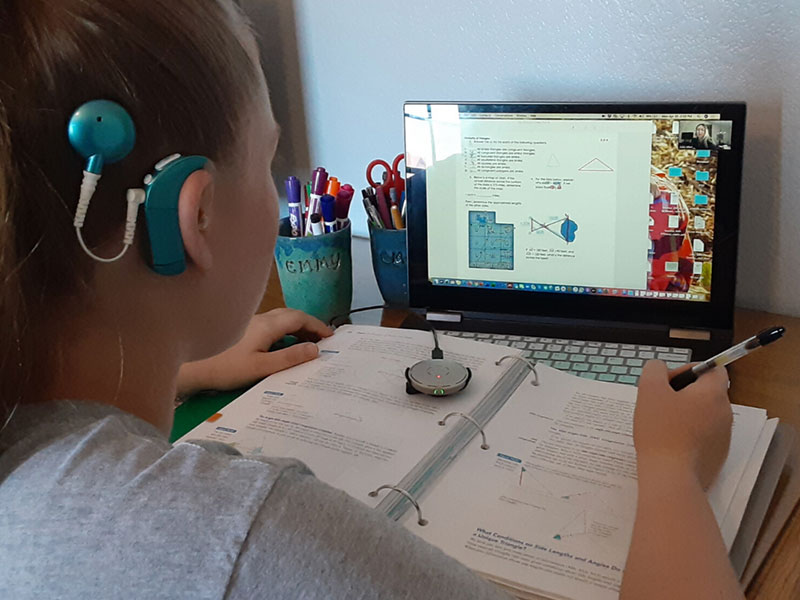There is only so much hearing aid and cochlear implant sound processing can do because the incoming signal captured by the microphone is already compromised.
Table of Contents
- Why is hearing in noise or over distance so hard for people with hearing loss?
- How can listeners hear better in these situations, then?
- What are remote wireless microphones?
- Tell us about some situations where remote wireless microphones can be helpful.
- Can any CI or hearing aid receive signals from a remote wireless microphone?
- Are remote wireless microphones helpful for young children?
- If the remote wireless microphone has to be placed closer to the speaker, is there any worry that if the speaker’s shouting, it may damage the ears of the listener?
- How should CI and hearing aid listeners determine which remote wireless microphone will suit their needs?
When Cochlear Implants or Hearing Aids Aren't Enough – Remote wireless microphones deliver

Hearing aids and cochlear implants are life-changing solutions for people with hearing loss. But as many of those already using these devices will tell you, there are frankly still situations where even these amazing technologies aren’t enough to help them hear and understand speech.
When the noise in the room gets too loud, or when the speaker is far away on the other side of the auditorium, people struggle even with the state-of-the-art cochlear implant or hearing aids. To learn more about why that is, and what we can do in those situations, we spoke to Cecilia Zugaib, the Roger Marketing Manager at Sonova.
Why is hearing in noise or over distance so hard for people with hearing loss?
CZ: These are situations where not only people with hearing loss struggle, but even those with normal hearing may have a hard time. This is because of a problem with SNR. SNR, or signal-to-noise ratio, is essentially the loudness difference between what we want to hear (the signal) and everything else (the noise). When the noise gets too loud, it drowns out the signal (usually speech) that we want to hear. These situations can happen in loud restaurants and canteens, boisterous classrooms, busy train stations, etc.
But they also happen in places where the room is large and the speaker is far away. In these cases, there may or may not be a lot of noise, but the signal comes from so far away that it’s too soft to be understood clearly. Echoes in large spaces, like places of worship or auditoriums, also become a form of noise that make hearing the signal difficult.
So, in these kinds of situations, there is only so much hearing aid and cochlear implant sound processing can do, because the incoming signal captured by the microphone is already compromised.
How can listeners hear better in these situations, then?
CZ: The solution is to get the listener as close to the signal source, or the speaker, as possible, while eliminating the noise. In noisy situations, turn off distracting noise sources if possible, or move the conversation to a quieter setting. When you’re far away from the speaker, say, in a lecture hall, get as close as possible.
When it’s not practically possible to be closer to the speaker or reduce the background noise or echo, use technology that can help bring the speaker’s voice to you, such as with remote wireless microphones.
What are remote wireless microphones?
CZ: Remote wireless microphones are exactly what they sound like, instead of just relying on the microphones on your cochlear implants or hearing aids, remote wireless microphones can be placed close to the speaker’s voice. Then the signal from the microphone is wirelessly transmitted to a receiver attached to or inside your CI or hearing aid. This way, the speaker’s voice is brought directly into your ears in high quality, bypassing the physical distance and surrounding noise.
Tell us about some situations where remote wireless microphones can be helpful.
CZ: There are different kinds of remote wireless microphones designed for different listening situations. For example, there are ones that you can put on the table during meetings to hear your colleagues better around the room, or pointed towards your lunch date in a noisy cafe. Some are designed to be worn around the neck of the speaker. So if it’s your child with the hearing devices, you can wear a remote wireless microphone around your neck at a busy playground so your child will always hear you even while they’re running around.
Can any CI or hearing aid receive signals from a remote wireless microphone?
CZ: Remote wireless microphones require receivers on the listener’s end to pick up the signal. So oftentimes, CIs or hearing aids need to have a special accessory attached in order to use the remote wireless microphone. Thankfully, this is not always the case. The Phonak Roger system, for example, works with Advanced Bionics Marvel CI and certain Phonak hearing aids without an additional physical attachment on the hearing device. Once the audiologist has installed the Roger receiver into the Marvel CI sound processor, it’s a simple plug-and-play for the listener to use.
Are remote wireless microphones helpful for young children?
CZ: Yes! In the first years of the child’s life, it is very important that the child hear as many words as possible in order to develop speech and language and build relationships that will help them understand the world, strengthen brain architecture, and support the development of communication and social skills.1

A study shows that using Roger at home provides preschool children with access to 11 more words a minute, when compared to wearing hearing aids alone. This amounts to 5,300 more words in an eight-hour day.2 Therefore, using Roger microphones with your child from early on will be highly beneficial.
In fact, as soon as your child is fit with hearing technology and is walking, you can consider a remote wireless microphone system. This technology is especially beneficial when you are at a distance from your child and in noisy situations. Some typical use cases are: while driving, at the playground, when pushing the child in the stroller, at restaurants, at day care, or in school.
In fact, as soon as your child is fit with hearing technology and is walking, you can consider a remote wireless microphone system.
If the remote wireless microphone has to be placed closer to the speaker, is there any worry that if the speaker’s shouting, it may damage the ears of the listener?
CZ: Great question! It’s important to make sure that the remote wireless microphone (as well as the hearing aids or CI) have controls in place that limit how loud the signal can get. This way, even if the incoming speech is very loud, the technology will prevent it from becoming damaging to the listener.
How should CI and hearing aid listeners determine which remote wireless microphone will suit their needs?
CZ: For private use, either for a child, a teen, or an adult, choose a versatile one such as the Roger On™ that can be used at home, during sport trainings, in lectures, or during leisure time/social activities. For private use, but in situations where you expect to use it consistently in the same place, something like the Roger Select™ is ideal. If you are looking for a solution for work, especially if you spend a lot of time in meetings and group discussions, look for ones that can pick up sounds coming from all around, such as the Roger Table Mic II. Multiple Table Mics II can even be connected to create a network, so the listener will be able to hear everyone around large tables. Roger is one of the most widely used assistive listening systems in schools. So if your child’s school uses Roger, the Roger Touchscreen Mic is the best option.
-
National Scientific Council on the Developing Child. (2004). Brain architecture. Retrieved from https://developingchild.harvard.edu/science/key-concepts/brain-architecture/, accessed February 10th, 2022.
-
Benitez-Barrera, C..R, Angley G., & Tharpe, A.M. (2018). Remote microphone system use at home: Impact on caregiver talk. Journal of Speech, Language and Hearing Research, Vol. 61, 399-409.
